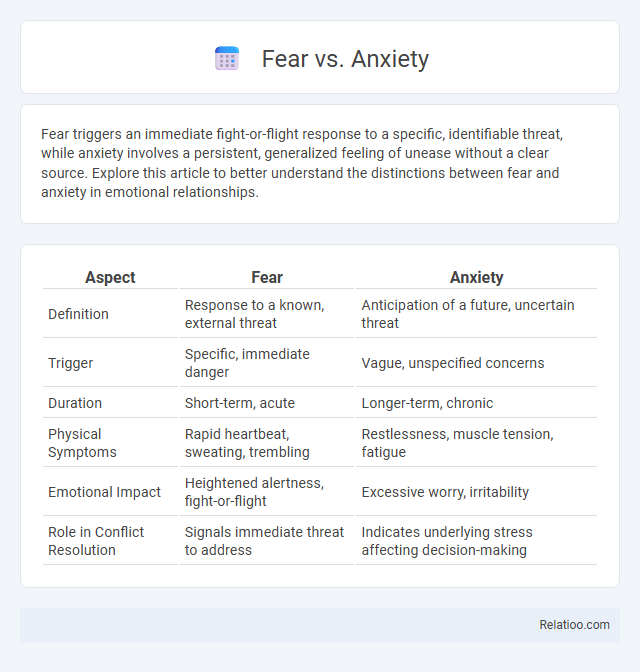Fear triggers an immediate fight-or-flight response to a specific, identifiable threat, while anxiety involves a persistent, generalized feeling of unease without a clear source. Explore this article to better understand the distinctions between fear and anxiety in emotional relationships.
Table of Comparison
| Aspect | Fear | Anxiety |
|---|---|---|
| Definition | Response to a known, external threat | Anticipation of a future, uncertain threat |
| Trigger | Specific, immediate danger | Vague, unspecified concerns |
| Duration | Short-term, acute | Longer-term, chronic |
| Physical Symptoms | Rapid heartbeat, sweating, trembling | Restlessness, muscle tension, fatigue |
| Emotional Impact | Heightened alertness, fight-or-flight | Excessive worry, irritability |
| Role in Conflict Resolution | Signals immediate threat to address | Indicates underlying stress affecting decision-making |
Understanding Fear: Definition and Characteristics
Fear is a natural, immediate emotional response to a real or perceived imminent threat, triggering the body's fight-or-flight reaction to ensure survival. Characterized by increased heart rate, heightened senses, and focused attention, fear is typically short-lived and specific to a clear danger. Understanding your fear involves recognizing these physiological changes and the direct relationship between the stimulus and your reaction, distinguishing it from anxiety, which is more chronic and generalized.
Anxiety Explained: Nature and Symptoms
Anxiety is a complex emotional response characterized by excessive worry, nervousness, and apprehension about future events or uncertain outcomes, distinct from fear, which is an immediate reaction to a real threat. Your experience of anxiety often includes physical symptoms such as increased heart rate, sweating, muscle tension, and difficulty concentrating, reflecting the body's heightened state of arousal. Understanding the nature of anxiety helps differentiate it from fear and highlights the importance of managing its persistent psychological and physiological effects.
The Biological Basis: Fear vs Anxiety
Fear activates the amygdala and triggers the fight-or-flight response as a reaction to immediate, identifiable threats, while anxiety involves prolonged activation of the brain's stress circuits, particularly in the prefrontal cortex and hippocampus, linked to anticipation of potential future dangers. Your brain's neurochemical systems, including neurotransmitters like norepinephrine and cortisol, play crucial roles in differentiating acute fear from chronic anxiety. Understanding these biological mechanisms is essential for effective treatment and management of fear-related and anxiety disorders.
Emotional Triggers: What Sets Them Apart?
Fear arises from an immediate, identifiable threat triggering a survival-focused emotional response, while anxiety involves anticipation of a future, often uncertain, negative event causing persistent unease. Emotional triggers for fear are typically external, such as a loud noise or a threatening animal, whereas anxiety's triggers are more internal, including worries about health or social situations. Understanding these distinctions helps in targeting therapeutic interventions, such as cognitive-behavioral therapy for anxiety and exposure therapy for fear.
Psychological Impact: Fear and Anxiety Compared
Fear triggers an immediate response to a concrete threat, activating your body's fight-or-flight mechanism, while anxiety involves prolonged anticipation of potential future dangers, often causing chronic stress. Fear typically declines once the threat disappears, but anxiety persists, potentially leading to impaired cognitive function and emotional regulation. Understanding these distinctions helps in managing your psychological well-being more effectively.
Adaptive Roles: When Are Fear and Anxiety Helpful?
Fear triggers an immediate survival response to clear and present danger, activating the fight-or-flight mechanism essential for avoiding physical harm. Anxiety serves as a cautious anticipation of potential threats, promoting vigilance and preparation for future challenges without direct exposure to danger. Both fear and anxiety play adaptive roles by enhancing decision-making and alertness, ultimately improving an individual's ability to respond effectively in uncertain or threatening situations.
Chronic Anxiety vs Acute Fear: Key Differences
Chronic anxiety involves persistent, long-lasting feelings of worry that can disrupt Your daily life, while acute fear is a sudden, intense response to an immediate threat. Fear triggers a rapid fight-or-flight reaction, whereas chronic anxiety often causes ongoing tension without a specific cause. Understanding these key differences is essential for identifying appropriate treatments and managing symptoms effectively.
Coping Strategies for Fear and Anxiety
Effective coping strategies for fear and anxiety include cognitive-behavioral techniques such as reframing negative thoughts and practicing mindfulness to stay grounded in the present moment. Exposure therapy gradually reduces fear responses by controlled, repeated contact with the feared object or situation, while relaxation methods like deep breathing and progressive muscle relaxation help manage physiological symptoms. Establishing a consistent routine and seeking professional support when symptoms persist are crucial for long-term management and improving overall emotional resilience.
When to Seek Help: Identifying Problematic Patterns
Fear and anxiety are natural responses to stress, but when your feelings become overwhelming, persistent, or interfere with daily activities, it may indicate a problematic pattern requiring professional help. Symptoms such as excessive worry, panic attacks, avoidance behaviors, or physical manifestations like rapid heartbeat signal the need to consult a mental health expert. Recognizing these signs early ensures you receive appropriate support to manage and overcome debilitating fear or anxiety.
Building Resilience: Managing Fear and Anxiety
Fear triggers an immediate response to a known threat, while anxiety involves worry about potential future dangers, both activating your body's stress mechanisms. Building resilience involves developing coping strategies such as mindfulness, cognitive-behavioral techniques, and exposure therapy to reduce the impact of these emotions. Managing fear and anxiety effectively enhances your mental health, allowing you to face challenges with greater confidence and stability.

Infographic: Fear vs Anxiety
 relatioo.com
relatioo.com